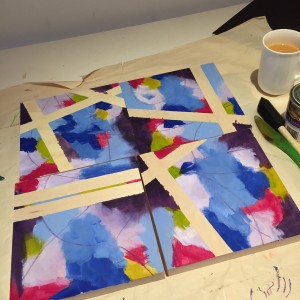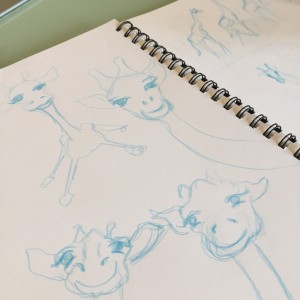From little things, big things grow - if you persist
I am finding the sacred geometry in these mandalas rather fascinating. There is something rather special about placing one circle after another in its series and trusting that it you do that enough times this beautiful floral lattice pattern will appear without you even trying.
There is a lesson in that to be sure.
Small steps made consistently build into something that may not even seem possible when you start out. Each small circle - each step - may not seem like much in and of itself. But if you persist with those little and seemingly inconsequential steps you find that from little things, big things grow.
Happy New Year. May 2016 bring you all that you need.
Don't overthink it
I tend to gravitate towards cooler, calming colour schemes. This time I decided to warm things up a bit with happy oranges and yellows. I also wanted to play with some of the more masculine, angular shapes in contrast to all the feminine curves.
So all in all, far too much thinking. It always turns out that the mandalas I draw with little or no thought, in a far more random, doodley fashion are the ones I end up liking the best.
I think the lesson for me in today's mandala is don't overthink it. Just do it.
There is always something to be said for having a plan and intentionally trying to incorporate something different. Inevitably you will learn something. But to act from a place of instinct and embrace ease is a considerably more uplifting, soul enriching experience.
If you are a planner, or prone to overthinking, give yourself a day off once in awhile. Let it unfold. It doesn't always have to be so hard.
Just start - the muse will be along shortly
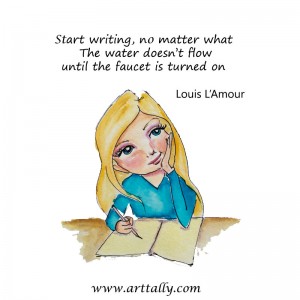 Sometimes the best way to begin is just to start. Too much priming, preparation and research can be immobilising. It opens the door to the inner critic before you have even made your first move. Whether it is a writer facing a blank page or a painter in front of a blank canvas the feeling is the same.
Sometimes the best way to begin is just to start. Too much priming, preparation and research can be immobilising. It opens the door to the inner critic before you have even made your first move. Whether it is a writer facing a blank page or a painter in front of a blank canvas the feeling is the same.
What if it turns out to be terrible?
What if I can't think of anything?
What if I don't do my idea justice?
What if I am actually no good at this?
You have to give yourself permission to try - and give your creative product the chance to be however it is going to be. Good, bad or otherwise. But as Louis L'Amour tells us, nothing happens unless you open that faucet. Don't be waiting to be 'ready'. That may never happen.
Don't wait around for inspiration. You have to get going, the muse will follow. Elizabeth Gilbert has a heart felt TED talk on this - check it out here.
Whatever it is that you are planning to do... go ahead - just start! You will never find out until you begin.
Does everyone have a novel in them?
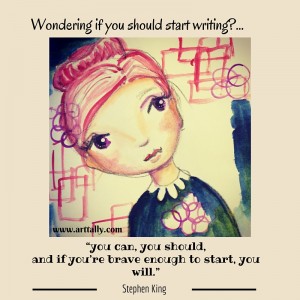 Yesterday I began my Nanowrimo 2015 challenge of writing 1667 words every day. I have to say it was a blast. That's something of a relief because I obviously have 29 more days to go.
Yesterday I began my Nanowrimo 2015 challenge of writing 1667 words every day. I have to say it was a blast. That's something of a relief because I obviously have 29 more days to go.
It was more fun than I anticipated. I have had these characters swimming about fuzzily in my head for the last few weeks. I have felt a fair bit of concern about what I would do with them when I finally started writing. Now I can happily report (yes, I know... its only day one!) that it is tremendously fun being the puppet master moving them about, controlling their every word and breath and relationship. Such power! You have to try it.
I met a lady at a local writers group who said she is always writing stories which contain versions of the people around her. She dealt with her marital breakup by throwing a fictional representation of her husband into a science fiction tale and wreaking merciless havoc upon him. I totally get it now. And that chap she had a set to with in the car park over a parking space? Met his doom in the chapter she wrote that night, of course.
They say everyone has a novel in them. For a long time I wondered if that was indeed true and worried that if I actually tried I might discover the answer to the question if I gave it a try. And not the answer I hoped for.
More optimistically though, there are those who say we do not have a novel in us. We actually have many many novels in us. Story telling is a natural thing all humans do. Sure some are better than others, but every one of us has recounted a past event or experience. Every one of us has already told many a tale. The rest is deliberate practice.
I can't think of a more encouraging way to start than with hundreds of thousands of other people all over the world this November.
Whether for fun, catharsis or the simple joy of tap, tap, tapping away at a keyboard , you might want to give writing a try. As Stephen King says,
You can, you should, and if you are brave enough to start, you will.
A new perspective
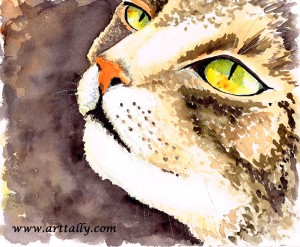 Sometimes a new perspective can make all the difference. At the start of the week I was finding it hard to keep drawing cats. So I decided to change things up a little - but still keep within my theme for the month.
Sometimes a new perspective can make all the difference. At the start of the week I was finding it hard to keep drawing cats. So I decided to change things up a little - but still keep within my theme for the month.
One of my favourite parts of any painting is the eyes. Today I drew a close up of a cat's face giving me a chance to draw bigger eyes, with more scope for the details I love so much.
Happily I can report that I loved every part of this painting process. Sketching was fun because it was a little bit more of a challenge to try and get all those important proportions right. And a new angle means you have to look harder - even at a familiar subject.
Painting was fun too. A new angle meant different brush strokes would work better as shapes and details were all larger. I must admit I experienced the same sort of delight when I painted an unusual pose earlier in the series - do you remember this one? A small adjustment like a change in angle, light, distance or pose can make a big difference.
It is funny how a new perspective can be all it takes to breath new life and enthusiasm into a tired project or problem.
What do you think? Has a new perspective worked for you before?
Learning to draw is good for you
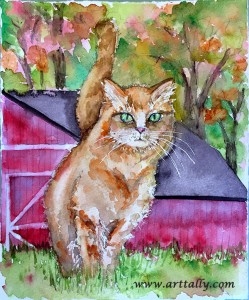 This is Redford. He is my fourth project in the Crazy Cats class with Miriam Schulman.
This is Redford. He is my fourth project in the Crazy Cats class with Miriam Schulman.
This project felt a little more daunting than the others, somehow. It felt like it required a lot more drawing. I procrastinated a fair bit before I started this painting, and I think it was mostly because of the drawing aspect. That's the thing with watercolour, isn't it? Most of the time you really need to be able to start with a decent sketch, so if you are uncomfortable drawing it makes watercolour painting really hard.
Funnily enough, the part I enjoyed the most with this painting was the drawing. Having to spend a little more time on the sketch gave me a chance to remember that I really love the process of drawing. It is one of the most relaxing creative pursuits I can think of. If you can stop worrying about how it is going to turn out, and surrender to the process of careful observation and mark making, time slips by. You can escape the world for a moment and just be in the present, enjoying the tactile experience of marking textured paper with graphite. Taking the time to appreciate lights and shadows, shapes and lines.
And then as an added bonus when you are done you get to splash colour and water all over it. Can't think of a better way to pass an hour or two...
Painting white flowers can be a tricky business
 Painting white flowers can present something of a challenge. White watercolour paint will just not do. Painting white flowers on white paper leaves you with little option but to paint them by not painting them at all. You have to paint the negative space around them leaving the untouched part of the paper to make the outline of the white flower. Then you can improve its shape and form by adding in some shadows.
Painting white flowers can present something of a challenge. White watercolour paint will just not do. Painting white flowers on white paper leaves you with little option but to paint them by not painting them at all. You have to paint the negative space around them leaving the untouched part of the paper to make the outline of the white flower. Then you can improve its shape and form by adding in some shadows.
It's a fascinating idea to have the daisy represented more by the space it takes up and the shadows it casts than by its own form. It makes me wonder if that is a little like the way we live our lives. Our impact is felt by the space we take up, and the imprint we leave behind. We can't help but be shaped by the way the world treats us. In equal measure, we leave our own mark on the world. Our environment and the people around us are changed by our presence. Hopefully for the better.
Occupy your space in the world proudly. Cast happy shadows. May the imprint you leave behind today be as joyful as the daisy's.
Mindfulness... the easy way
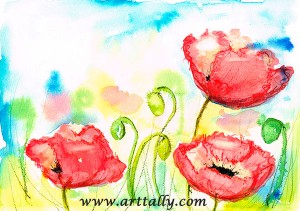 This morning I have spent the day surrounded by paint and paper and watercolour pencils and crayons. It is a glorious way to escape the world for a few hours and surrender completely to a joyful absorbing task. To me it is one of the easiest ways to practice mindfulness.
This morning I have spent the day surrounded by paint and paper and watercolour pencils and crayons. It is a glorious way to escape the world for a few hours and surrender completely to a joyful absorbing task. To me it is one of the easiest ways to practice mindfulness.
Mindfulness describes being fully present in the moment. Being aware of what is and accepting it without judgement. Learning mindfulness helps us to find more balance in our lives through greater emotional equilibrium. We can learn to be less affected by the external environment. It can help us become more aware of our own negative thought patterns and enable us to replace them with more helpful ones. It can increase our effectiveness in our work and improve our relationships with other people. Small wonder we hear about it so often and see it used by coaches, therapists and business people.
There are many ways to practice mindfulness. There is a short but helpful document from the Black Dog Institute that is a great starting point. It suggests meditation, as well as practicing mindfulness during regular activities such as eating and walking.
My favourite way to practice is with some sort of happy creative activity. Choosing an activity that you do purely for the sake of recreation and allowing it to absorb your attention. Perhaps that is why it is easier. If it is a task you enjoy it draws your attention effortlessly rather than you having to try and consciously maintain your focus. I don't think it really matters what the activity is. Baking, knitting, drawing, painting or colouring in a colouring book. Its all good for you.
At last, something that is good for you that you can actually enjoy doing.
The art of procrastination
 Some days you can spend hours at the computer, busily working away. Click, click, type, type. No end of activity. Sounds productive. And then eventually you realise that it is because you decided you desperately needed to take a free online typing test to check your typing speed. Because this of course is of greater or at least equal importance to working on that post you committed to write, or all those other tasks on the list.
Some days you can spend hours at the computer, busily working away. Click, click, type, type. No end of activity. Sounds productive. And then eventually you realise that it is because you decided you desperately needed to take a free online typing test to check your typing speed. Because this of course is of greater or at least equal importance to working on that post you committed to write, or all those other tasks on the list.
There are many battles to be fought in the creative process. It is practice for everyday life. There is a complete gauntlet to be run each time you try to indulge your creative urges. If the inner critic doesn't thwart you, procrastination might.
Its a sneaky beast, this Procrastination. Sometimes it is in disguise. It can cloak itself in the guise of research. Maybe planning. Getting organised. These things are all very valid, potential productivity enhancing activities. However, they are ancillary, support activities, not the main event. Important? Yes. Helpful? Yes. But if they are standing between you and the task at hand, efficient they are not.
If you feel busy then you may not realise that you are procrastinating. Procrastinating, sounds like you are not doing much. Therefore if you are actively engaged in furious activity you can't be procrastinating.
Procrastination is fear of beginning. Researching, planning and getting organised are all helpful activities that will ensure that your project gets off to a good start. But they are the preliminaries. This preliminary phase needs to be curtailed. Preparation is always key to setting up your project for success. Eventually you have to ask yourself if you are just procrastinating. There is never 'enough' research. You have to just start, even if you don't feel ready.
The bible on getting things done is called Getting Things Done by David Allen. But if your procrastination time budget does not extend to reading a whole book here are 29 lifehacks for procrastination instead.
How to manage your inner critic
 I was supposed to post Face no 12... this one above, yesterday. I drew her. I was not pleased. I decided to begin again. Having completed Face no 13, I concluded she was worse than Face no 12. Ah, the inner critic.
I was supposed to post Face no 12... this one above, yesterday. I drew her. I was not pleased. I decided to begin again. Having completed Face no 13, I concluded she was worse than Face no 12. Ah, the inner critic.
When the inner critic pipes up with her judgement, it is easy to feel paralysed. To just stop seems an easier, and far more sensible solution than to continue.
 The inner critic is a defense mechanism. Her aim is to reduce our risk. To prevent us from being judged by others, and possibly hurt in the process. However, despite these good intentions, sometimes she succeeds only in strangling the muse, and any motivation to act on any creative urge.
The inner critic is a defense mechanism. Her aim is to reduce our risk. To prevent us from being judged by others, and possibly hurt in the process. However, despite these good intentions, sometimes she succeeds only in strangling the muse, and any motivation to act on any creative urge.
Learning how to manage your inner critic stems from that awareness. Knowing that it is a protective mechanism we can acknowledge and appreciate the self care intention. From this much gentler place we can assess more rationally the seriousness of the risk perceived by the inner critic.
To make that evaluation you need to return to your 'why'. Why are you creating? There are a host of valid reasons. In fact, I don't think I can think of an invalid one. But the mere fact that you began the creation process suggests that it is a necessary self expression. We all have the right to express ourselves, regardless of our talent or ability. To create just for the sake of creating. As the creator, your job is to create, not to judge the creation.
Create because you feel the inclination to create.
Create because it gives you joy.
Create for the delight of the process.
Let the output of your creative process be whatever it will be. Inevitably, with practice you can only become better. But if you let the inner critic thwart your process in the early stages, you will never get to see that for yourself.
How is your happiness project going?
 Is happiness one of your priorities? Probably, yes.
Is happiness one of your priorities? Probably, yes.
If you ask most people what they want in life, chances are they will eventually say that they want to be happy. So most of us want happiness, but do we actually do anything to actively seek it?
Gretchen Rubin did. She devoted a year of her life to her happiness project it in fact, and wrote a book about it.
I think it is something we should all consider. Not writing a book about it, necessarily... but what we actually do for ourselves daily in the pursuit of happiness.
Do you know what makes you happy? What do you do for fun?
I suspect far too many of us may have lost sight of the true answers to these questions. Those answers are easily subsumed by expectations we hold of what sensible, appropriate grown ups should do with their leisure time. That of course assumes that we haven't given up on the idea of leisure entirely, in the pursuit of 'success', whatever that may mean to us.
Reading Rubin's account of working through these questions is certainly thought provoking. I have to admit, my initial thoughts included the worrying doubt that devoting a year of a life to one's personal happiness might just be a touch self-indulgent. How telling... I now conclude that it is not at all a selfish luxury. Rather more a responsibility. Each of us brings our energy to the world. Each of us is responsible for choosing what sort of energy that will be.
"Happiness is the meaning and purpose of life, the whole aim and end of human existence." Aristotle
The Happiness Project is not a prescriptive instructional manual. It is more like a diary of Rubin's year long project. It concludes with suggestions on how to start one's own happiness project, recognising that no two projects will be alike. It is up to each one of us to work out what it would take to increase our happiness. If you are wondering where to begin, then I highly recommend this book. Not only for the delightful, personal writing, but for the extensive resource lists at the end of the book.
To my mind, our whole lives are our happiness projects. I wholeheartedly support the idea of setting clear goals of things to add to our lives, or things to change in order to increase our everyday happiness. Analysis, setting objectives and determining measurable action steps to achieve these things - of course I like all that. But I don't see it as the work of a finite period of time. No indeed, that is the work of a lifetime.
How to make a big goal manageable with tiny steps
A couple of months ago I resolved to create something every day and post it here. I have been pretty good at keeping this up but last week I seemed to be wavering.
I have also been doing the 100 day project with Elle Luna at The Great Discontent. I took up the additional challenge to post a daily 10 minute journal every single day for 100 days. Last week I completed that 100 days. Yay! (You can check it out on Instagram by the way).
Completing a challenge like this is rather motivating. It helped me remember how important it is to take tiny steps towards your goal. As the Chinese proverb says,
"The man who removes a mountain begins by carrying away small stones."
This is really the only way to take a great big goal, and turn it into something manageable. Never underestimate the cumulative power of small repeated actions. The big picture goal can be overwhelming. Choices too, can be overwhelming. So devising a plan of tiny steps is a way of taking a large abstract goal or objective and making it into a series of executable actions without the distraction of having to decide what to do next. For me, the overarching objective of learning to draw and paint better is now simply a question of turning up every day and making a painting of a predetermined subject. Much more achievable.
My main objective is to be creative every day, and to learn to draw and paint. Sometimes the writing part of my posts is a bit of a distraction. The main purpose is to keep drawing. And I am rather pleased with my subject choice for this month. It turns out that drawing curvy exotic teapots and then decorating them is a surprisingly relaxing pastime... who knew!
"Success is the sum of small efforts, repeated day in and day out." - Robert Collier
Explore more of the Tea Time series posts here
Use your artist's eyes to find a little more daily happiness
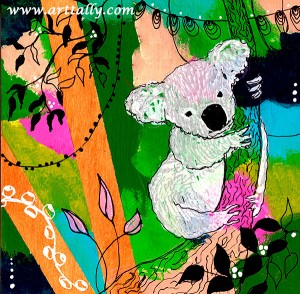 It is a privilege to be able to see the world through artist's eyes. The same privilege as it is to see the world through the eyes of a child. Have you ever taken a walk with a three year old? In 100m there will be a surprising amount of fascinating diversions. Every ant, shadow and unusual shaped leaf can absorb and entertain a child. We probably don’t even notice these things.
It is a privilege to be able to see the world through artist's eyes. The same privilege as it is to see the world through the eyes of a child. Have you ever taken a walk with a three year old? In 100m there will be a surprising amount of fascinating diversions. Every ant, shadow and unusual shaped leaf can absorb and entertain a child. We probably don’t even notice these things.
But if you are open to it, as we all are as children, there is awe and beauty in every dewdrop balanced on a leaf tip, the shafts of new light through the trees, the contrast of red and gold autumnal leaves against a perfect blue sky.
Finding the joy in these things is the path to a little more happiness in every day. Far more so than in the ‘big’ things, like winning the lottery or getting that promotion.
If you want to reawaken that child-like awe, the easiest way to do it so to draw something. You don't need to draw well, you just need to practice using your artist's eyes. And yes, we do all have artist's eyes, whether you believe it or not.
Drawing is 90% looking and 10% drawing. It requires the abandonment of judgement and preconception. You know that the your teacup is round but right now, from this angle, the rim actually looks like an oval. You know mountains don’t really have blue grass but right now those mountains do indeed look blue .
Being required to see things just as they appear rather than how you think they are supposed to be, forces you to really notice your world. If you draw and paint regularly you start to see the world in all its glory again. The shadow pattern made on the carpet by the light from the window can somehow enthrall. The arrangement of a throw, a pillow and book tossed on your chair in the living room delights. Maybe it's the composition. Maybe it is the marriage of colours - quite coincidental but even more lovely for it. These small things are enough to lift your spirits just that little bit.
In a world that bombards us with a constant stream of usually less than positive news events, the little dose of happy to be found in every part of our environment is just the counterbalance we need.
Count on a giraffe to brighten your day
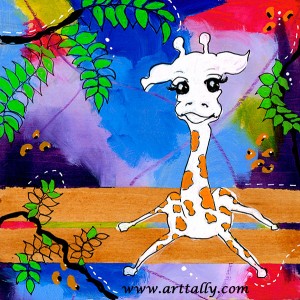 I am painting giraffes this week, and a jolly cheery thing it is to do.
I am painting giraffes this week, and a jolly cheery thing it is to do.
I started out with bright colourful backgrounds I loved .... (and a cup of tea)
And then did some sketches of various giraffes...
and then found that I was quite paralysed when it came to putting the giraffes on the backgrounds. It is hard when you have something you like in the background because you can't help but worry about messing it up. And in a sketch, all is forgiven. Lines that are not quite right seem okay in the sketch, but when you start painting the sketch they start to scream at you.
However, I bravely committed. And I am now resolving to paint more giraffes because they are such a remarkable animal. A most unusual beast. I have learned all sorts of things about them (no fear.... there is more on that in another post...) but today there is something else I want to share.
There is a most wonderful story about a giraffe. It is a children's story... my very favourite kind of story. Like all the best children's stories it has a message for us all. It is a tale about celebrating your uniqueness, forging your own path, knowing you can do anything you put your mind to by finding your own special way.
The book is called Giraffes Can't Dance by Giles Andreae. There are also narrated videos of the picture book available on You Tube. Happily I watched quite a few of them today.... all in the name of research. I think this one is my favourite. Check it out - it's very short, and sure to brighten your day (whatever age you may be).... here is the link.
How to feel calmer in one minute
Here we are at monkey number 4. It always feels rather good to get to the end of a complete series. This little monkey is sitting quietly noticing the world around her. We all need to do that too. Being busy is easy. It feels inevitable somehow. Remembering to take a little time out and sit for a moment.... that is much harder. But so important.
I think we are probably all aware of how valuable meditation is, but how many of us have managed to make this a habit?
For many of us the excuse is time. Somehow finding time in the day to sit and essentially 'do nothing' seems impossible and even counterproductive if you schedule is stretched already. The other excuse is that it is too hard, it takes too long to learn, that you are too restless and can't quieten your thoughts.
How much easier would your life be in you knew how to feel calmer in one minute?
Because one minute is actually all you need.
Even one minute of sitting quietly can make you feel significantly better. Whether it is a little anxiety, a little frustration, overwhelm, or tiredness, you might just be surprised at the difference a minute can make. Try it and see... its worth a shot. Here is a little video that explains it all and gives you a chance to try it now for yourself. And there is a free app you can download called One Minute Meditation.
I love the idea of taking one minute to reset. No yoga mat, no meditation cushion. But I do rather like having a bit of help. By which I mean that while a moment of silence is immensely valuable, there are times when I like to have some more specific audio guidance.
If you do too, you might appreciate the free resources available at just-a-minute.org. There are a series of one minute meditations available that cover all sorts of things such as visualisation, relaxation and concentration. They even have one minute meditations for kids. All these meditations are available free either to stream or download.
And may you have a calmer day because of it.
The importance of true grit
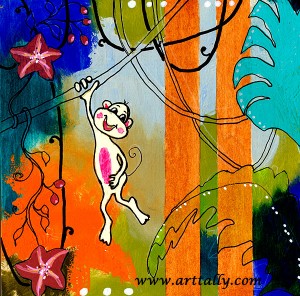 If I am honest, I have reached a bit of a lull in my quest to willingly post my daily creations. But I think this is an inevitable part of a creative process. The initial enthusiasm that comes with a new idea gets you going. Then that steam runs out and it becomes a question of persistence. To keep on placing one foot in front of the other. Now is the time to understand the importance of true grit.
If I am honest, I have reached a bit of a lull in my quest to willingly post my daily creations. But I think this is an inevitable part of a creative process. The initial enthusiasm that comes with a new idea gets you going. Then that steam runs out and it becomes a question of persistence. To keep on placing one foot in front of the other. Now is the time to understand the importance of true grit.
Jerry Seinfeld talks about marking a cross on the calendar every day that he does some writing. The point is to make a chain of crosses. Not to write something brilliant. But simply to show up and write. Every day.
So I feel that that is where I am right now. Making the most of the opportunity to demonstrate that I have some grit. I really don't like that word, somehow. But persistence (grit) has been shown to be a key predictor of success. (There is a TED talk by Angela Lee Duckworth that explains the importance of grit, if you happen to be in the mood for a vid!)
To be persistent you have to be okay with imperfection, with failure even. Persistence is continuing in spite of setbacks. A setback can just be a call to your creativity, awakening your problem solving equipment in order to find a way to move forward.
“The most important thing about art is to work. Nothing else matters except sitting down every day and trying.” ― Steven Pressfield
Persistence is probably what the 'p' stands for in professional. An amateur stops when things become hard, or when enthusiasm and inspiration wane. A professional continues doggedly on, whether they feel like it or not. Writers know all about this. For example,
“I write only when inspiration strikes. Fortunately it strikes every morning at nine o'clock sharp.” ― W. Somerset Maugham
The effort of persisting is very worthwhile, though. It is helpful to keep a mental note of past successes achieved through perseverance. Recalling these successes is a great encouragement when your persistence is being tested again. So I have seen for myself that continual practice, in small but steady ways really does build your skills. I am choosing to see this as an opportunity to rack up another mental note of successful perseverance in the memory banks. We will mark the occasion with this whimsical monkey swinging through mixed media vines on a wooden panel.
By the way, there is a test you can do to determine how 'gritty' you actually are. So if you love a personality test or two (let's be honest... who doesn't?) you can try this one...
Put your stress in perspective
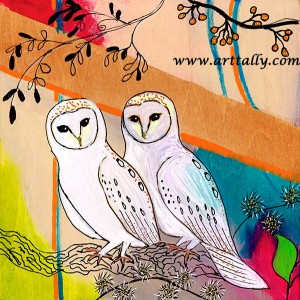 It is so easy to get embroiled in the minutiae of daily life. Chores pile on top of wish lists. Supermarket queues and incompetent drivers add a layer of frustration to the day. Everything seems urgent. Overwhelm can ensue.
It is so easy to get embroiled in the minutiae of daily life. Chores pile on top of wish lists. Supermarket queues and incompetent drivers add a layer of frustration to the day. Everything seems urgent. Overwhelm can ensue.
And then every so often, life sends you a little reminder to take a step back, to put things in perspective. Today, Thing Two (my son, age eight) cut his head open with a cricket bat. He is perfectly alright now, after a trip to the plastic surgeon to dig out the remaining bits of the bat and stitch everything back together.
A minor emergency is a great clarifier, it seems. Funny how when needs must, a full day's itinerary can be shelved to deal with something that actually is important.
The most valuable things in life are not on any to-do list. Caring for our loved ones, spending a moment to feel gratitude for our cherished families is a most helpful way to reevaluate our priorities.
Perhaps all those tasks on your list - in whatever stage of completion - are not worthy of the stress we allow them to cause us.
How to set up your new project for success
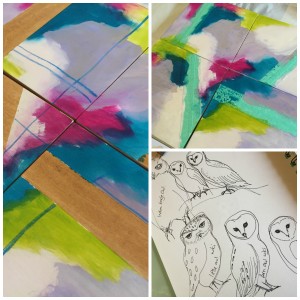 I start a new project every month. It's very exciting, but also a little scary. This month I am painting a series of square mixed media panels that feature animals. Last month it was flower faces on paper (see the finished gallery here!)
I start a new project every month. It's very exciting, but also a little scary. This month I am painting a series of square mixed media panels that feature animals. Last month it was flower faces on paper (see the finished gallery here!)
On the first working day of each month I get a fresh start. Here are five ideas to consider so that you set up your new project for success.
1.Start with why.
Try and articulate for yourself exactly why your are doing this project. Being clear about your purpose will enable you to evaluate your progress more fairly. It will be your guide post as you need to make decisions during the project. Simon Sinek explains that getting to the heart of why we do what we do is to tap into our own infinite source of inspiration and motivation.
2. The honeymoon phase
Enjoy the initial burst of enthusiasm that heralds the start of a new project. Celebrate it. Know that it is a part of the energy cycle of the project and it wont last. Anticipating this means you can try to avoid being disappointed that you didn't maintain your momentum or beat yourself up about it when the enthusiasm wanes. But make the most of the initial excitement - it is the impetus that gets you started.
3. Identify your requirements and resources.
Usually we are pretty good at figuring out what we are going to require in terms of materials for a project. But there is more to consider in preparing your project for success. Don't overlook the project's requirements in terms of time and support. Be realistic about how much time you will need to put in as well as any time requirements for other team members. Consider the resources you have available. Access to a mentor for example, can be an important resource, as can access to other additional help such as substitute/alternate team members or alternate suppliers as a back up in case of emergency.
4. Baby steps
How do you eat an elephant? One bite at a time. Even the most daunting task can be made easier to approach by breaking it down into small achievable steps. Once you have an idea of the steps, you can measure your progress by measuring the process rather than results. Your chances of success are far greater if you can focus on your systems rather than just your ultimate goal.
5. Give yourself a buffer.
Nothing goes according to plan. Where would the fun be in that anyway? But when things go awry it can knock you off schedule. Be kind to yourself and build in a bit of extra time in your schedule to deal with the unforeseen.
Why parenting teaches entrepreneurs about unstructured time and self discipline
Becoming an entrepreneur can be as overwhelming as becoming a new parent
Parenting teaches entrepreneurs about unstructured time and self discipline. A new parent is dispatched home with a sweet smelling bundle of joy, only to find themselves stepping into a sort of parallel universe. Day and night blur exhaustingly into one. Time loses its meaning. Day to day tasks that were once second nature like regular meals, doing laundry and managing to wear matching shoes become challenging.
That blur of overwhelm is very similar to the experience of the newly self employed. In fact, any significant life change that removes the structure of your day like children going to school or leaving home, being made redundant or retiring, can leave you with an an unsettling amount of unstructured time.
Unstructured time is not as brilliant as you might have hoped…
If you chose the change, unstructured time might be exactly what you were after. But sometimes it is not all you had hoped it would be. Studies have linked the increase in unstructured time experienced by those who are unemployed to low self esteem, hopelessness and inactivity . With too much time on our hands we end up having to face our demons. And with unstructured time the most likely outcome is often a significant lack of productivity.
Hopefully you find a creative endeavour to utilise this time. If the change was of your choosing, as in the case of the new entrepreneur this creative project might be the very reason for the change. You start a business, change career, write a novel, take up a hobby. That creative project is your new baby.
However, unlike the newborn baby your new project won't wail to let you know when you have missed an important activity like time for a feed or a nappy change. No, your new project is entirely silent. It is all on you to figure out what to do and when to do it.
Reduce that overwhelm with a solid structure
Most new parents learn pretty fast that the best way to manage this enormous life change is with a steady routine. That fuzzy haze of the first few days or weeks clears once a consistent schedule is established. And with a newborn baby, there are usually plenty of knowledgeable friends and relatives, who are more than willing to provide input.
Similarly, to thrive (or just survive) your new creative endeavour you have to manage that unstructured time with… yes, I’m afraid so… a bit of structure. It might be that unstructured time is what you wanted, but actually it is more like self-directed time. Maybe what you wanted was not to be answerable to anyone - unstructured time is the initial side effect.
Okay, so there are no busybody relatives and parenting gurus clamouring to be involved in what you do. But resources are readily available to help you come up with a structure. They are all largely common sense, as most good advice is. They likely begin with an assessment of goals and objectives. The next step is to break down the steps needed to achieve those goals and objectives. And finally, to schedule those priority tasks.
The key to success is self discipline
However, scheduling is not the final step at all. I think that this part is comparatively easy compared to the critical final component. Execution. Actually carrying out the tasks that have been scheduled. A crying baby is hard to ignore. You complete the necessary tasks without really thinking about it because the need, goals and objectives are obvious and time is scarce.
But with the new creative endeavour, it is easy to lose sight of the goals, and to lose the sense of urgency. The only thing that keeps us executing the tasks on our list is self discipline.
Business gurus like Bob Proctor and Brian Tracy advise that self-discipline is the most important characteristic of an entrepreneur. Often, the most productive time of our life is our school days. Thanks to a rigorously enforced and carefully thought out structure, we learn multiple subjects and skills, and include play, exercise and hopefully healthy eating on a daily basis.
Unfortunately, without teachers and parents and bosses we are accountable only to ourselves. With only self discipline to keep us on track we probably won’t achieve the volume and variety of learning and productive activity per day as we did at school. Nor do we always remember to take care of ourselves as well as we should. The most essential tool in our arsenal for success is self discipline.
Fortunately, self discipline is a learned skill. If it doesn't come naturally to you, you can still improve it with some effort.
Schedule out every part of your day. Do this before the day begins - at least the night before. Then follow your schedule unwaveringly, whether you feel like it or not. The sense of achievement when you carry this out is very motivating. Do it again tomorrow. And the next day.
Will you be able to do this every single day? Probably not. Don’t be too hard on yourself. We all have off days. Aim for the 80/20 rule… try and do this at least 8 out of every 10 and see your productivity sky rocket. Your self esteem and mental state will benefit too. Like anything, the more you practice, the easier it becomes.
Art and the importance of play
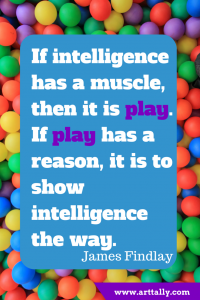 The importance of play
The importance of play
Quite a few years ago I was in the middle of a very long study programme. I was working. I had two small children. Every minute of my day seemed scripted. It also seemed to be mostly for satisfying other people’s needs. Then, seemingly out of the blue, I got it into my head that I wanted to learn the piano. I had never played an instrument before. I didn't have a piano. And I was very busy doing other ‘important’ things. But for some reason I heeded the call. I hired a digital piano, bought myself an online piano course and started to learn.
I’m so glad I did - despite that little voice in my head that kept saying What are you doing? This is so silly… Isn't it a waste of money? You really don't have time for these needless things…
But that was just the point. I needed exactly that. Something needless. Something just for me, that didn't really matter. I could be good at it or bad at it. Do it often or seldom. It was just for fun. I wanted to play.
What is play?
In his TED talk, Dr Stuart Brown used the word needless to explain what play is. He describes play as an activity that is more about process than outcome, that is done purely for enjoyment. He also says the opposite of play is depression. Play is vital.
Play is not just something children do in preparation for adulthood but a biological process necessary in all phases of life. Neuroscientists have worked out that play lights up our brains - there is even an entire scholarly journal dedicated to it, The American Journal of Play!
We all need to make time in each day for a bit of fun - a chance to play, even adults. In fact, I want to say, especially adults. Everyone agrees fun and play is important for children but we tend to overlook these things in adulthood. It was in watching my small child drawing that I realised grown ups need to play too - in fact that is what started my art journey.
Art is play
For me, art is play. According to the National Institute for Play, there are seven types of play:
- attunement play
- body play and movement
- object play
- social play
- imaginative and pretend play
- story telling and narrative play
- creative play.
Making art encompasses several of these. Artists work with their hands, manipulating objects such as pens, brushes, clay, paper. Working with our hands (object play) has been identified as an important way in which our brains develop problem solving abilities
Making art is a chance to escape into a fantasy world for a brief time, satisfying our need for self expression and developing the neural pathways required for innovative thinking (creative play).
Anyone who has every kept an art journal will be in no doubt that this process helps us to explain, describe and make sense of our world. This is what story-telling and narrative play is all about.
Daily play
Dr Dan Seigel recommends dividing our time between seven essential mental activities every day, for optimum health:
- sleep time
- physical time
- focus time
- down time
- time in
- play time
- connecting time
These things make up what he describes as our healthy daily platter - the mental equivalent of healthy food plate. Alongside things like sleeping, working and exercising we should be consciously setting aside play time.
How funny it is that once we become adults we need to be told to go and have some fun every day…
“Play is the gateway to vitality.
By its nature it is uniquely and intrinsically rewarding. It generates optimism, seeks out novelty, makes perseverance fun, leads to mastery, gives the immune system a bounce, fosters empathy and promotes a sense of belonging and community.” National Institute For Play
So what are you going to play at today?







